Table of Contents
Best Metal Guitar Scales
These tend to be the most used heavy metal guitar scales. Most of these scales are minor scales or Messiaen modes.
With that being said, you can use any scale you want for metal! Never forget this. Music has no rules.
I used A as a root note for all of these. This will allow you to compare the scales to one another in the same root position.
As you look at these scale, think about their interval structures more than the shapes themselves. The intervals relative to the root note are what give a scale it’s sound at the end of the day.
These scales are laid out in a variety of shapes. Some are CAGED, some are 3-notes-per-string, and others are played on single strings. In the long run it’s important to practice and learn each individual scale using all 3 methods.
Harmonic Minor
Harmonic Minor Scale Formula: 1-2-b3-4-5-b6-7
The harmonic minor scale is a natural minor scale with a major 7th, rather than a minor 7th.
This is usually played over a minor chord with the same root. It has a darker sound, and while it is popular in metal, it’s also very common in classical music!
The shape used below is the minor CAGED shape, with a major 7th instead of minor 7th.
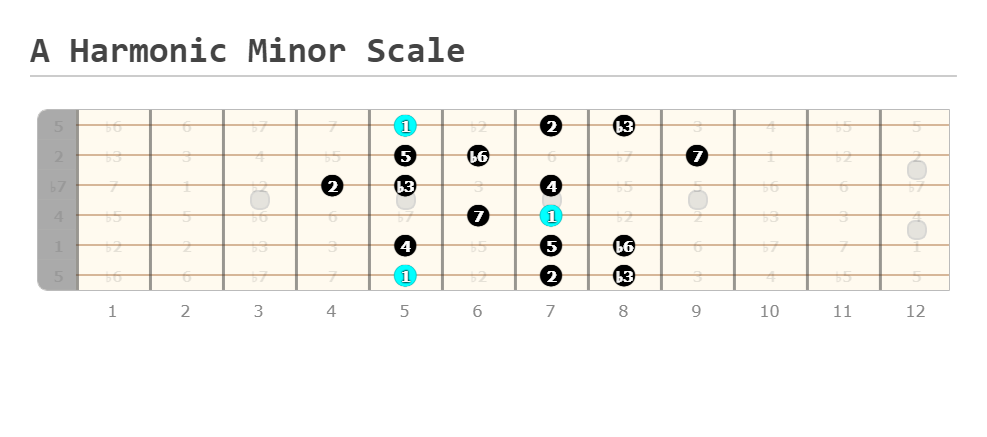
Phrygian Dominant
Phrygian Dominant Scale Formula: 1-b2-3-4-5-b6-b7
Phrygian dominant is the 5th mode of harmonic minor. It can be looked at like Phrygian with a Major 3rd rather a minor 3rd.
The chart below gives you the 3-notes-per-string position, because that’s my favorite way to play it. This one shape alone can open up a wide variety of compositional ideas.
One of the unique features of the Phrygian dominant scale is the fact that you can build a major triad (1-3-5) from the root note! This means it can be played over a major chord with the same root, and it will sound just as dark as it’s parent scale, harmonic minor.

Diminished
Half-Whole Diminished Scale Formula: 1-b2-b3-3-b5-5-6-b7
Whole-Half Diminished Scale Formula: 1-2-b3-4-b5-b6-6-7
The two formulas for diminished scales are found in the names: Half-whole and whole-half.
Starting from your root, you repeat either the half-whole or whole-half pattern, depending on which diminished scale you decide to use.
I opted to show how the scales work on single strings. I used two strings, the A and G strings, where you can see how the notes work one octave apart.
Playing the diminished scales on single strings will give you the best idea of how the intervals work in these scales.
You can learn more about this scale Here.
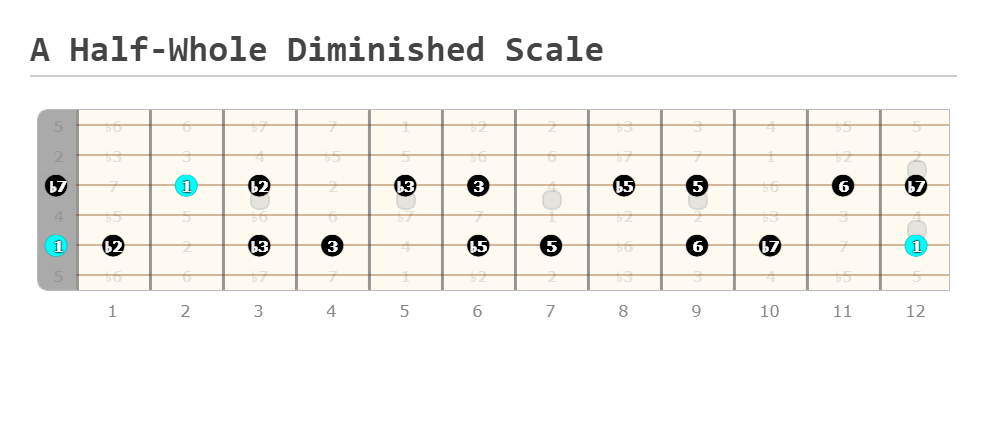

Whole Tone
Whole Tone Scale Formula: 1-2-3-b5-b6-b7
The whole tone scale is made up entirely of whole steps.
The diagram shows that whole tone scale in the fifth position, but it also shows the scale layout on the A string.
This scale is a breeze to play as long as you know where your root notes are, because you simply find the root and move up in whole steps!
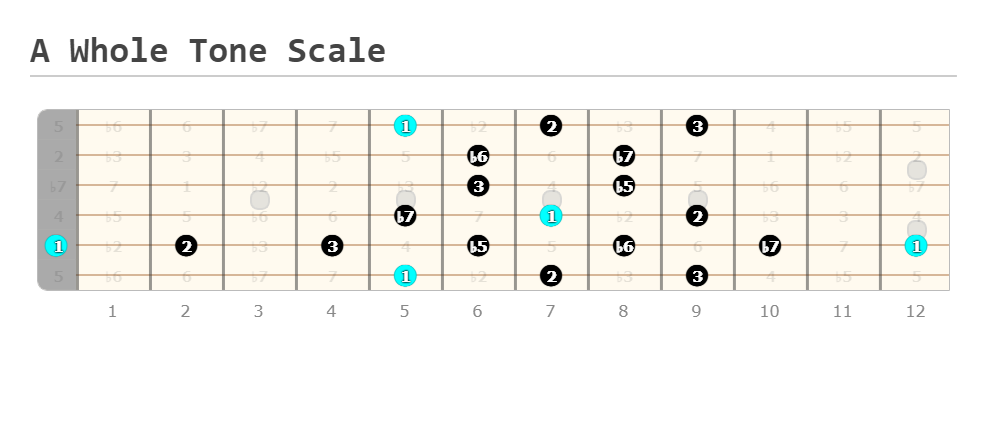
Augmented
Augmented Scale Formula: 1-b3-3-5-b6-7
The augmented scale is simple: move up a minor 3rd, then move up a half step, then repeat. This results in a 6-note scale.
I used a full fretboard diagram to demonstrate this scale, because it shows how you can use the same 2-note-per-string shape to play this scale in 3 different positions. These 3 positions start at these intervals: the 7th, the b3, and the 5th (all on the low E string).
Start by learning the 2-note-per-string shape at the b3 on the 8th fret of the low E. As you can see, the shape moves backwards.
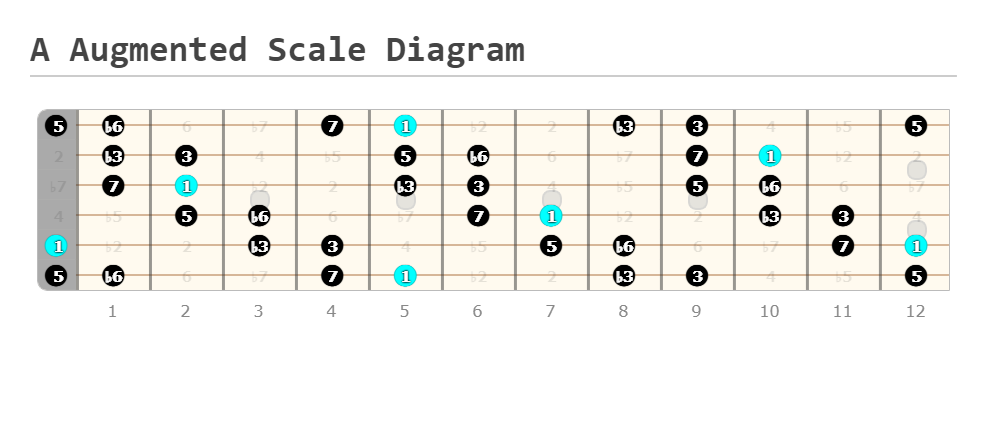
Blues Scale
Blues Scale Formula: 1-b3-4-b5-5-b7
Yes, the blues scale is used for a lot more styles than blues!
The blues note is so cool because it’s just a minor pentatonic scale with a passing tone between the 4th and the 5th.
This scale is super easy to learn and apply if you already know your minor pentatonic shapes.
Simply play your pentatonic scale like normal, and think of the b5 as a note to compliment your scale, rather than thinking of the blues scale by itself.
Check out this post about the blues scale to become a blues scale pro!

Natural Minor Scale (Aeolian)
Natural Minor Scale Formula: 1-2-b3-4-5-b6-b7
The natural minor scale is the most common and essential scale used in metal!
Its sad-sounding interval structure and relationship to the minor pentatonic scale make it a perfect candidate for music about war, death, and anything else that’s metal!
This is the CAGED position for the scale, but I highly suggest you learn the 3-notes-per-string shapes for this as well.

Minor Pentatonic
Minor Pentatonic Scale Formula: 1-b3-4-5-b7
The minor pentatonic scale is one of the easiest scales to learn and use. It’s a go-to scale candidate for lead and rhythm guitarists alike.
Its awesome sound paired with its simplicity makes this one of the best heavy metal guitar scales ever!
Learn all 5 minor pentatonic shapes here.

Lydian
Lydian Scale Formula: 1-2-3-#4-5-6-7
The Lydian scale is a major scale with a #4 instead of a perfect 4th. This odd interval layout gives the Lydian scale a happy vibe that somehow sends chills down your spine.
My favorite chord to play Lydian over is a Maj.7#4 chord, which is also an awesome jazz chord.
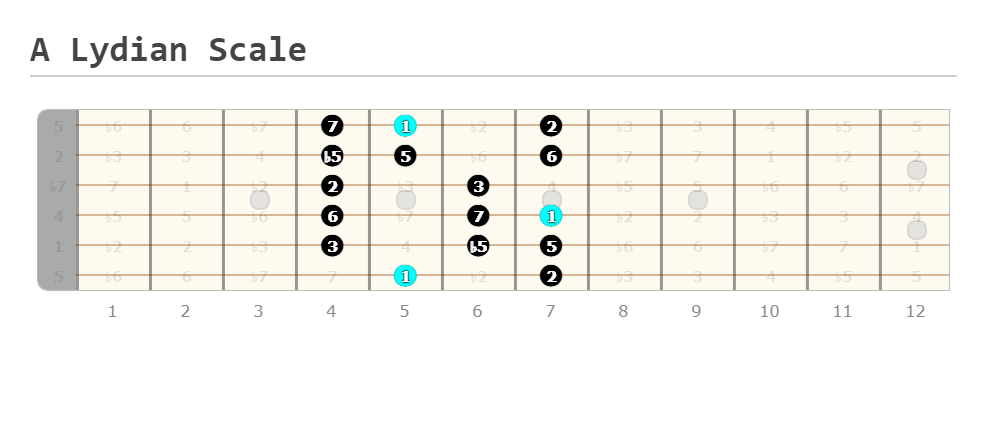
Hungarian Minor Scale
Hungarian Minor Scale Formula: 1-2-b3-b5-5-b6-7
Hungarian minor is arguably the most obscure and uncommon scale used on this list, but that means you can sound original and set yourself apart from other metal guitarists by using the scale.
That being said, the scale does sound quite avant-garde, and that’s probably why it’s not used very often.
The decision to use this scale should be based on whether you’re writing music for yourself or your listeners.
Aside from that, this can be a great scale for either situation if used for lead guitar.

Common questions about metal guitar scales
What scale is best for metal?
There are three metal guitar scales I see used the most:
- Natural Minor (Aeolian)
- Minor Pentatonic
- Harmonic Minor
What key is most metal music in?
Most metal music is an the key of E minor, E flat minor, or D minor.
However, with more music being played in drop tunings and on extended range guitars (7 and 8 strings) we are seeing more keys playing roles in modern metal, such as C# minor, F# minor, and B minor.
However, as a whole every musical key has been used at one point or another in metal music.
Summary: Metal guitar scales
To summarize, there are lots of metal guitar scales, and you should learn the ones that best suit your style.
Some of these scales are more common than others, but they all have a role in metal music.
When thinking about the best metal guitar scales to use, think about how you want a riff or lick to sound.
So, which scale is your favorite? Let me know in the comments below.


